By Samantha Ancona Esselmann, Ph.D., a 23andMe Ancestry Scientist
Puerto Rican writer Aurora Levins Morales reflected on what it means to have mixed heritage in her poem, “Child of the Americas,” which concludes:
“I am not African.
Africa is in me, but I cannot return.
I am not Taína.
Taíno is in me, but there is no way back.
I am not European.
Europe lives in me, but I have no home there.
I am new. History made me. My first language is Spanglish.
I was born at the crossroads
and I am whole.”
In the poem, Levins Morales acknowledges her diverse roots—a combination of African, European, and Indigenous American—but chooses to celebrate and identify with her Puerto Rican identity.
Today, the Americas are a genetic crossroads, home to many people like Levins Morales, with identities forged by waves of migration and a fusion of cultures.
A New Feature Which Explores Latino & Caribbean Ancestry
In our ongoing efforts to deliver a more intuitive and comprehensive 23andMe Ancestry Composition report, we’ve released a new feature called “Recent Ancestry in the Americas” for customers with ancestry from Central America, South America, and the Caribbean. In tandem with 23andMe’s Ancestry Composition report, this new feature enables these customers to explore their heritage in a more recent timeframe — following the mixing of historically separate populations that occurred in the Americas over the last few hundred years.
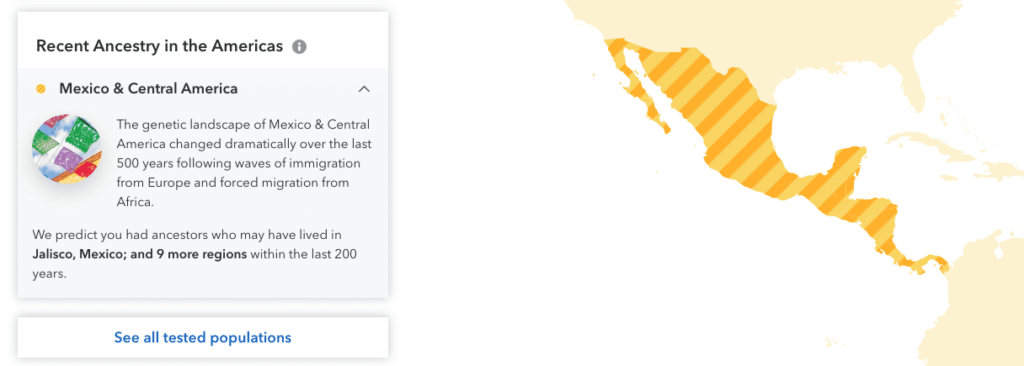
In addition, customers with ancestry from Jamaica, Haiti, and 10 other countries in the Caribbean may see an exciting new level of detail about places their ancestors may have lived. This is in the form of more granular maps. Over time, these maps will continuously update to reflect the growing size and diversity of 23andMe’s database.
What does the word “Latino” or “LatinX mean?
We use Latino or the gender-neutral term LatinX to broadly describe any person from, or with roots in, Latin America. That includes a vast area encompassing Central and South America and the Caribbean.
Sometimes, people use the word Hispanic, Latino, or LatinX interchangeably, but Hispanic is a little more specific. Hispanic includes anyone from a Spanish-speaking country in the Americas, but not, for example, someone from Brazil, a Portuguese-speaking country. It’s also important to note that being Latino could mean that a person has European ancestry, African ancestry, Indigenous American ancestry, or often a mix of the three.
Recent Ancestry in the Americas
(new countries marked in green)
The Caribbean
Antigua and Barbuda, Aruba, Bahamas, Barbados, Cuba, Dominica, Dominican Republic, Grenada, Haiti, Jamaica, Martinique, Puerto Rico, St. Lucia, St. Vincent and the Grenadines, Trinidad and Tobago
Mexico & Central America
Belize, Costa Rica, El Salvador, Honduras, Guatemala, Mexico, Nicaragua, Panama
South America
Argentina, Bolivia, Brazil, Chile, Colombia, Ecuador, Guyana, Paraguay, Peru, Uruguay, Venezuela
What’s included in this update?
In each of the three new reports, customers will see a brief genetic history of the region, a map highlighting sub-country regions where we have found evidence of their recent ancestry, and educational content to provide additional scientific and historical context. We’ve also included short stories that sample aesthetics, flavors, and traditions that may inspire customers to connect with aspects of their heritage.
We encourage customers to contribute ideas for future stories by leaving feedback at the link included in each Ancestry Detail Report.
How can I find these new Ancestry Detail reports?
If you have ancestry from one of these regions, this new section will appear below your percentages in your Ancestry Composition report.
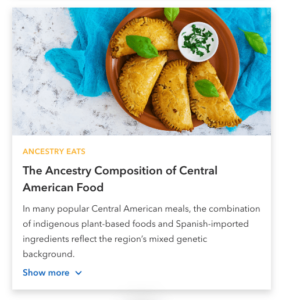
You can access these new reports through Ancestry Overview, the all-reports tab, or find them in Scientific Details.
Not yet a customer? Visit our store!
Notably, “Recent Ancestry in the Americas” should complement your Ancestry Composition percentages. Together, both results should help you better understand your ancestry and how it may have changed over time.
A snapshot of genetic diversity in the Caribbean and Latin America
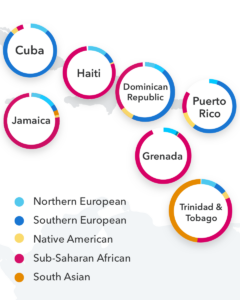
The Caribbean
The Ancestry Composition breakdown of 23andMe customers from countries in the Caribbean typically reflects southern European, West African, or Native American ancestry. While customers from Spanish-speaking islands generally have a combination of all three of these ancestries, customers from Haiti, Jamaica, Grenada, or other smaller islands have little Indigenous heritage and a much higher proportion of West African ancestry. This is a result of the large numbers of enslaved Africans transported to the Caribbean over nearly four centuries.
What is the Caribbean?
The Caribbean, sometimes called the West Indies, includes any islands and surrounding coasts of the Caribbean Sea. The more than 7,000 islands and islets form an arch that spans from the Leeward Islands to the west up through the tip of Cuba to the east. The region’s rich and diverse culture and history consists of a blend of indigenous, African, European, Indian, and Chinese influences.
Did you know?
Native Caribbean ancestry — primarily from the Indigenous Taíino peoples who once called these islands home — is still found in Puerto Rico, Cuba, and the Dominican Republic (former colonies of Spain). But it is almost completely absent on the islands formerly claimed by Britain and France. On average, Puerto Ricans have around 12 percent of this Taíno ancestry, but over 60 percent of their maternal-line ancestry is of Taíno origin.
Mexico & Central America
Customers from Mexico & Central America often have a combination of Native American,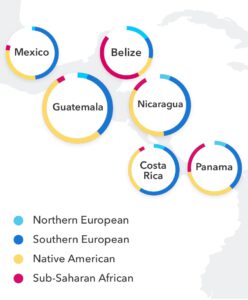 southern European, and West African ancestry in their DNA. However, the breakdown varies throughout the region. Native American ancestry generally reaches its highest levels in Mexico, El Salvador, and Guatemala. West African ancestry ranges from an average of 2 percent in Mexico to over 40 percent in Belize. Today, most 23andMe customers with Mexican or Central American ancestry have at least 1 percent African DNA. This reflects admixture many generations ago, early in the Transatlantic Slave trade.
southern European, and West African ancestry in their DNA. However, the breakdown varies throughout the region. Native American ancestry generally reaches its highest levels in Mexico, El Salvador, and Guatemala. West African ancestry ranges from an average of 2 percent in Mexico to over 40 percent in Belize. Today, most 23andMe customers with Mexican or Central American ancestry have at least 1 percent African DNA. This reflects admixture many generations ago, early in the Transatlantic Slave trade.
Did you know?
Among 23andMe customers from Mexico & Central America, the predominant African ancestry is Senegambian & Guinean. The predominant African ancestry in much of the Caribbean and the United States of America is Nigerian.
South America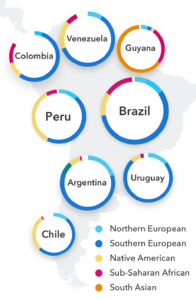
23andMe customers from Ecuador or Peru typically have over 45 percent Native American ancestry. Brazil, Argentina, and Uruguay customers tend to have less than 10 percent of this genetic heritage. Indigenous ancestry remains highest where there were once large agricultural civilizations. However, many factors likely contributed to the variable rates of Native American ancestry across the continent.
What about African ancestry?
For 23andMe customers from Colombia or Venezuela, the most common African ancestry is Senegambian & Guinean. Customers from Brazil typically have more Angolan & Congolese ancestry. Between the 17th and 19th centuries, Portugal transported as many as five million enslaved Africans to Brazil. These enslaved Africans were primarily from Angola and the Congo River basin. Today, an African genetic signature peaks among 23andMe customers with roots in the east Brazilian state of Bahia.
Did you know?
23andMe customers from Guyana and Suriname have high levels of African genetic heritage? The region is often considered more culturally and politically aligned with the Caribbean than the rest of South America.
To learn more about these regions’ genetic history and diversity, check out the educational modules near the top of each new report!
Caribbean Report
Mexican & Central American Report
South American Report
Explore Your Latino or Caribbean DNA
You can go directly to your ancestry reports overview to learn more. Not yet a customer? Check out everything you can learn about your ancestral origins using 23andMe’s Ancestry Service.



